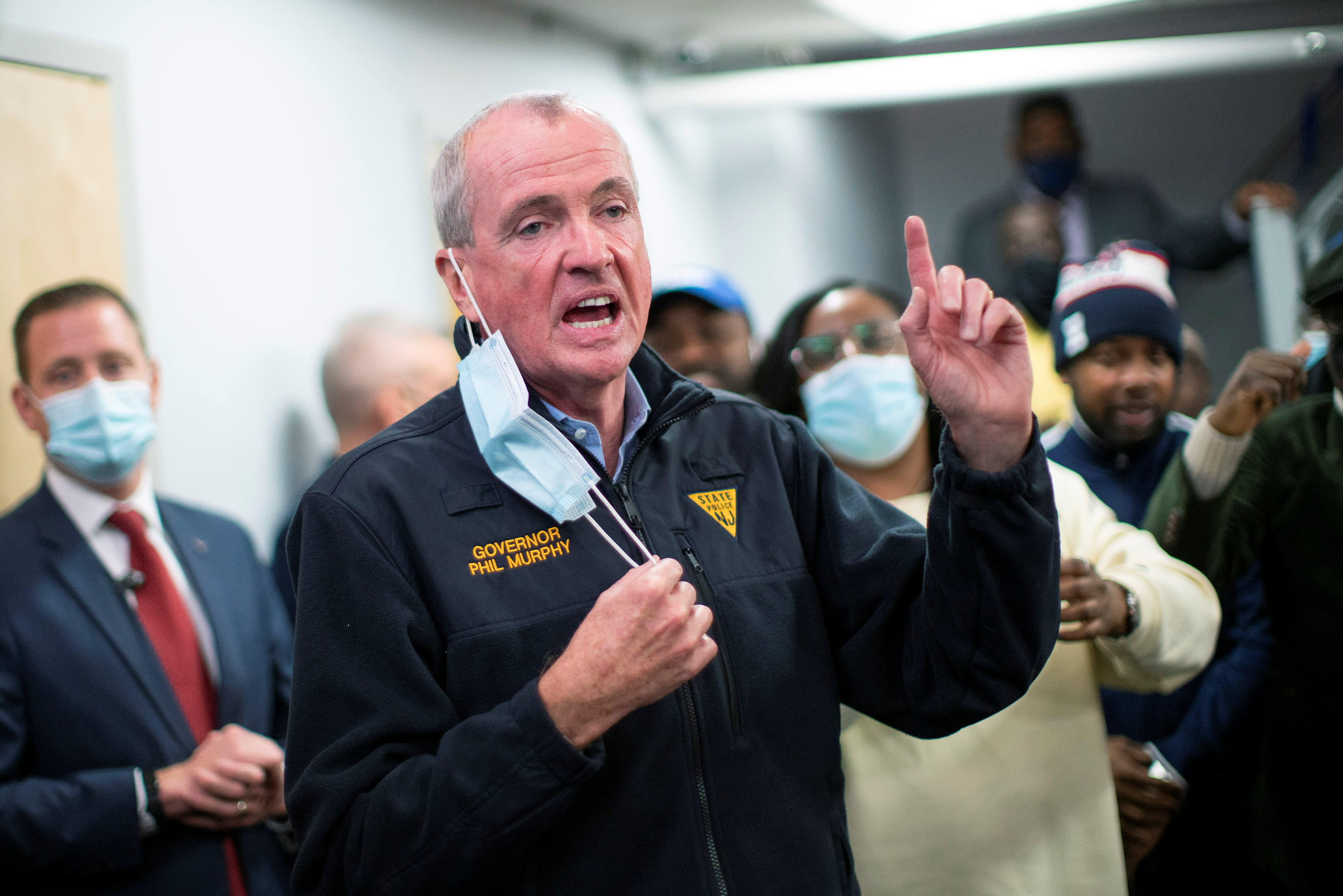Messy job reports and unreliable labor data forecasts take a toll on Biden in his first year
In 2021, the Labor Department's initial monthly jobs report and Wall Street's estimates have been less reliable — and President Biden paid the political price.

U.S. President Joe Biden gives remarks in the Statuary Hall of the U.S. Capitol during a ceremony on the first anniversary of the January 6, 2021 attack on the U.S. Capitol by supporters of former President Donald Trump in Washington, D.C., U.S., January 6, 2022.
Drew Angerer | Reuters
To say that the Labor Department's regular jobs report is important would be to undersell what many consider something of a monthly economic holiday.
That data, which includes the official measure of national unemployment and monthly job creation, not only shapes economic forecasts. It also serves as a potent political barometer, an instant report card on the success or failure of a U.S. president's economic plan. It can sway consumer attitudes in the short term and influence voters every two years.
An assumption that the government provides accurate numbers underpins the emphasis on the monthly update.
Now the Covid-19 pandemic has made the Bureau of Labor Statistics' job harder, and its initial monthly report far less accurate. And President Joe Biden, who will mark a year in office Jan. 20, has paid a political price as his party tries to hold control of Congress in November's midterm elections.
BLS blues?
Throughout 2020 and 2021, Labor Department surveyors have had a difficult time counting job creation. Biden and most Americans have seen initial figures that often understate the true job growth.
The average monthly revision to the Labor Department's jobs report has topped 100,000 so far for 2021. The figure could change, as the government has not published a final update for November and December revisions.
If that figure holds, it would mark the most extreme miss in nonfarm payrolls estimates in at least 40 years, even when adjusted for the growth of the U.S. labor force, a CNBC analysis of BLS data found.
The effect of those revisions over time appears even more profound.
If the economy added as many jobs as first reported between January and October, the U.S. would have tallied 4.9 million jobs over the first 10 months of 2021. After revisions, though, data show the U.S. actually added 6 million jobs over those months.
CNBC excluded November and December from the calculation because the BLS has not published its final revisions for those months. The Labor Department's initially projected job gains of 249,000 and 199,000, respectively, for those months. It would put the 2021 total above 6.4 million jobs added.
The revisions have looked even more stark in specific months of 2021.
When the Labor Department first reported employment figures for January 2021, it put month-over-month net job creation at a mere 49,000. After revisions, the government said January's gain came to 233,000 jobs, more than quadruple the original reading.
Something similar happened the next month. The Bureau of Labor Statistics first said that U.S. employers added 379,000 jobs in February 2021. Weeks later, the BLS revised that number up to 536,000, meaning that most people who read the initial jobs report saw a figure 157,000 jobs below the final total.
People often mistakenly believe the preliminary data is "wrong" because the government later revises it, Tyler Downing, a senior economist at the Labor Department's Division of Current Employment Statistics, said in an email.
"No, we got it right, based on what the sample told us," he wrote. "At each publication, the estimates are accurate based on the sample that is received and calculation of seasonal adjustment factors."
Downing added that the BLS in 2021 saw one of its lowest data collection rates for its first preliminary release, or the report released on the first Friday of every month. It is unclear exactly what has made data collection more difficult during the economic recovery from the pandemic this year.
The Labor Department based its 2021 jobs reports off a smaller pool of data than usual, meaning the first estimate lacked it usual precision. The annual average collection rate came in at 69.8% of the total number of businesses sampled. The last time it was that low was 2008.
By the third and final release, the Division of Current Employment Statistics usually has a collection rate above 90%.
"Collection rates for first preliminary estimates have risen from an average 65.0 percent in 2003 to 73.5 percent in 2020," Downing wrote. "There will, however, always be a lag with some businesses, because they simply do not have their payrolls completely processed."
Not-so-great expectations
The understated reports and subsequent revisions wouldn't be as problematic in Washington if Wall Street did not focus so much on economists' forecasts prior to the jobs report. The focus on whether the report beats expectations could have implications for Biden and his party at the polls this year.
Dozens of news media outlets, including CNBC, cite surveys of economists in stories published ahead of the Labor Department's official release. Doing so helps reporters set readers' expectations for job growth and gives them insight into what Wall Street expects since many traders buy and sell based on their outlook for the broader U.S. economy.
But the pandemic has also undermined the models economists use to forecast payrolls growth. Government and private-sector economists have for years adjusted the jobs numbers based on the season.
In the best of times, forecasters have a difficult time predicting human behavior. But adding a pandemic to the mix has upended even the most modest models of human behaviors, from travel and indoor dining patterns to adherence to public health advisories. Wall Street's economics models — like those at the Labor Department — have become less accurate as a result.
Early last year, economists polled by Dow Jones said they expected the U.S. economy to add 50,000 jobs in January 2021. The actual number after revisions came in at 233,000.
Ahead of the February report, those same economists projected a gain of 210,000 jobs. Their estimate fell 326,000 short of the final print of 536,000.
The average monthly projection from Dow Jones' group of economists fell 254,000 jobs per month short of the final revised figures in 2021, according to a CNBC analysis of the numbers.
The gap between estimates and final numbers has been much narrower in recent years. For instance, in 2017, the average difference between economist expectations for monthly job growth and the final revised figures was just 30,000 jobs, about 1/9th as many as last year.
Of the 12 preliminary Labor Department jobs report in 2021, seven fell short of, or "missed," Dow Jones expectations.
An uphill battle
The combination of nosier initial government data and less accurate projections from economists has contributed to a tough reality for the Biden administration.
The White House has tended to face harsh headlines on days the monthly jobs reports come out for "missed expectations." Then voters do not seem to reward Biden for the large revisions that come weeks later.
Some 58% of voters say they disapprove of how Biden is handling the U.S. job market, according to a CNBC/Change Research poll published earlier this month. That's even worse than their views on the job market overall: 52% of those surveyed said they see the current state of the U.S. job market as either "poor" or "not so good."
Sixty percent of the survey's 1,895 respondents said they disapprove of Biden's handling of the economy, a six-percentage-point decline in approval from September.
Many political analysts say the president's flagging polling numbers suggest Democrats could face a tough election cycle in 2022. Some have pointed to Republican Glenn Youngkin's victory over Democrat Terry McAuliffe in Virginia's November gubernatorial race as evidence that the GOP could flip control of Congress this year.
The GOP victory is notable because Biden won Virginia by 10 percentage points in 2020.
History already suggests a rough year for Biden, as the president's party typically loses seats in the first midterm after their victory. Poor approval of his handling of the job market — combined with inflation running at its highest levels in decades — likely will not help.
The Labor Department's first look at the U.S. jobs market for December 2021 showed the national unemployment rate under 4% and 199,000 jobs added last month. While any recent number needs to be taken in the context of an economic recovery, when companies add jobs more quickly, a look at pre-Covid trends would suggest December was a strong month for jobs.
The average monthly nonfarm payrolls gain in 2017 was 181,000. That number rose to 193,000 in 2018 and retreated to 168,000 in 2019.
A majority of economists say an unemployment rate under 4% is strong evidence that the U.S. labor market has neared full employment.
But economics are not politics. Republicans seized upon the disparity between the number of jobs added versus expectations after the release on Friday.
"The latest jobs report was not only a December disappointment, it was Biden's worst jobs report yet," Sen. Ted Cruz, R-Texas, wrote in a Twitter post on Friday.
The House Republican conference explicitly referenced news coverage about the report falling short of Wall Street expectations.
"President Biden just had the worst jobs report of his presidency in December. American workers can't afford 'another big miss' from this administration," read a post from the House Republican Twitter account.
Democrats hold razor-thin majorities in both chambers of Congress. The Senate is split 50-50 between the parties. Democrats hold a narrow 221-212 advantage in the House.
As Democrats face the threat of losing control of Congress — and their ability to pass Biden's economic agenda — the White House has tried to counter the souring opinion on the job market and economy.
Council of Economic Advisers Chair Cecilia Rouse has made a habit of pointing out the larger-than-average fluctuations in the jobs reports. She published a blog post earlier in January after the seemingly underwhelming December jobs report that underscored the point.
"Jobs numbers are generally revised twice before they are considered relatively 'final,'" Rouse wrote. "As the Administration stresses every month, the monthly employment and unemployment figures can be volatile, and payroll employment estimates can be subject to substantial revision."
— CNBC's Nate Rattner contributed to this report.

 Kass
Kass 
































